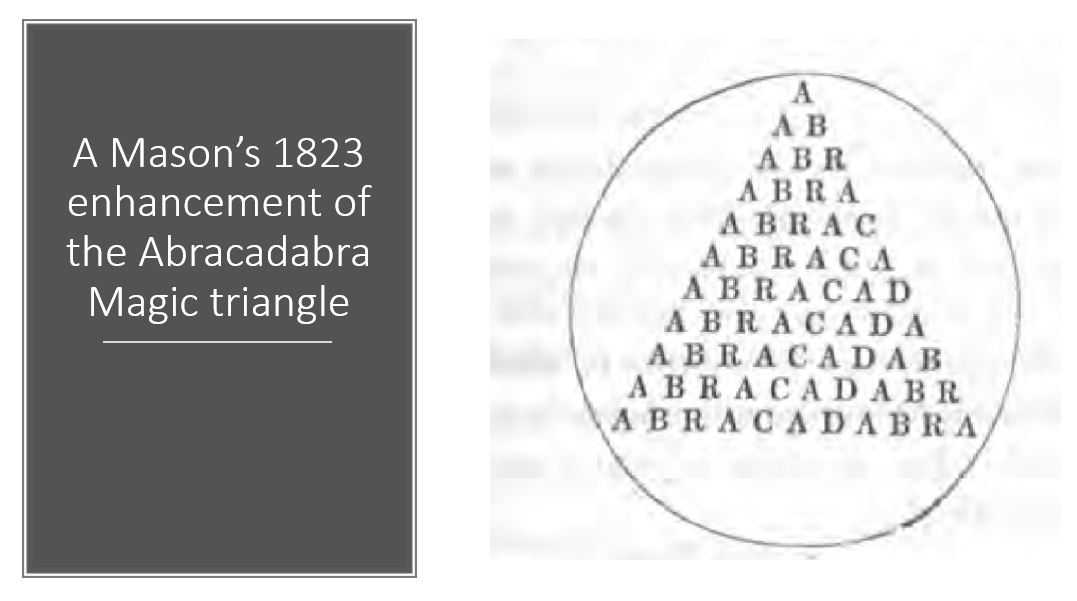Clair: Lucy Mack Smith, when she was writing her family memoir. She had several drafts, and we have the earlier drafts. In this early draft, she says something to the effect, “Well, we didn’t spend all of our time trying to win the faculty of Abrac, or soothsaying or drawing magic circles, we did attend to our business and took care of it.” That’s it, in essence, and then she doesn’t go on and then the next draft, there’s nothing. So we have this tantalizing tidbit and it’s interesting to go, “Hmm, what in the world is she talking about?” Well, we know, of course, the Smiths were heavily involved in treasure seeking. This phraseology is, I believe, about treasure seeking. But it also has a Masonic origin, an interesting Masonic origin. So Abracadabra was a magic word. It goes way, way back. It probably had something to do with trying to conjure up the deity Abraxas and you can find it in all sorts of books going way back. If you narrow that down, though, to the word Abrac, so Abracadabra. If you draw a triangle, a magic triangle, and the bottom line has Abracadabra, and then it’s a little shorter and shorter. At the top is letter A, that is a magic abracadabra triangle.
 Abracadabra triangle. Courtesy Clair Barrus
Abracadabra triangle. Courtesy Clair Barrus
…
Clair: Magic Circle is not in the Leland manuscript, but it is something that the Smiths did, and other treasure seekers [did] when trying to recover a buried treasure. When you draw a magic circle with a dagger, and the Smith’s had a ceremonial dagger with an occult symbol in it, it was quite likely used for drawing magic circles in the ground. When a magician would draw a magic circle, it was used to either keep spirits out or keep them in or to protect the magician that was in the circle or protect others that were in the circle. It was creating a magical barrier that couldn’t be crossed.
GT: When you’re saying magician, you’re not using that in today’s term where it’s just a guy who does optical illusions.
Clair: This is not parlor tricks.
GT: This is actually, they believed they were doing magic.
Clair: Yes, this is ceremonial magic. This is something the Smiths did. If we want, I can read a very interesting quote about Joseph Smith, Sr. Well, I’ll just summarize it. Joseph Smith, Sr. drew two magic circles. Then he puts rods of witch hazel sticks around the two circles and then in the very center he draws in a rod of iron. What he’s really doing is creating a cone. There’s an outer circle and an inner circle and then a point. It’s supposed to represent a 3D cone going down into the ground, holding the treasure at this point inside of this cone. Then Joseph Smith, Sr. walks around the circle three times, and he’s described as muttering. Well, he’s probably using magic words, a spell, some kind of ceremonial magic and maybe the word abracadabra might have been part of it. We don’t know, or Abrac or something. Then that’s supposed to help protect the treasure from the spirits.
Clair: He then goes into the house and asks Joseph Smith, who is looking in his seer stone in the hat and he says, “Joseph.” And then they dig. They had dug, and there’s no treasure. They go in the house, “Joseph what happened?” he says. He [Joseph, Jr.] has been watching the spirit interacting with this cone, these magic circles that Joseph Smith, Sr. has drawn. Joseph [Jr.] said that the Spirit was able to get the treasure and move it through the earth and they lost it. They had made a mistake during some part of the ritual, and that’s why they lost the treasure. It’s a fascinating account. I can’t remember if it’s William Stafford that wrote this. It’s a fascinating account. It gives you [a] very detailed [account] into what the Smiths would do.
Find out more about magic lamens! Check out our conversation…and don’t miss our previous conversations with Clair!
